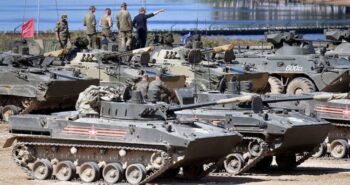A rare look at the fight against ISIL in the eastern Libyan city of Derna in the constant flux of the post-Gaddafi era.
Libya’s Shifting Sands is a two-part series offering a rare glimpse into the fight against the Islamic State of Iraq and the Levant (ISIL, also known as ISIS) in two strategically important cities of Derna and Sirte.
The 2011 Arab Spring saw the fall of heads of government in Tunisia, Egypt and Libya. A series of internationally recognised but unstable governments in Tripoli failed to unify the country or revive the economy.
Amid the chaos, weak border controls and a lack of effective government, ISIL started to gain a foothold in the eastern coastal city of Derna during 2012; and then in Sirte during 2014.
In 2015, a United Nations peace deal proposed a Government of National Accord (GNA) in Libya, seen as the best way to combat the increasing threat of ISIL. A coalition of Islamist armed groups emerged in Derna under the banner of the shura council, heavily opposed to ISIL.
At the same time, Khalifa Haftar, a general from the Gaddafi era, formed his own, self-proclaimed “Libyan National Army” and began “Operation Dignity”, a military campaign against local shura council armed groups in several cities, especially Benghazi. He labelled them “terrorists” because he saw them as having supported the 2011 revolution against Gaddafi – and presented himself as the sole guarantor of Libyan stability.
Haftar is a polarising figure, criticised by some for his aggressive use of force but praised by others for attempting to restore order to a war-torn country.
To complicate matters further, the GNA recently offered him the job of heading up the Libyan Army itself, on condition that he recognise the GNA.
During the confrontation in Derna, those fighting ISIL raised questions as to whether there was some sort of relationship between ISIL and Haftar’s Operation Dignity.
“More than 22 ISIL fighters who fled Derna city are now free in Dignity Forces-controlled areas,” says Colonel Muftah Hamza, a Libyan army commander who fought ISIL in Derna. “I have evidence with their names.”
Anti-ISIL armed groups, along with the Libyan army, seized control of the strategically important crossroads al-Heela, aiming to cut off their supply lines and access to other parts of the country.
“The effort made by the Derna mujahideen shura council, seizing control of the entrance to al-Heela, was heroic and made sacrifices … revolutionaries from Derna, Tobruk and Bayda joined and we made great advances,” says Colonel Saleh Sahad, a Libyan army commander in Derna.
Realising they’d been surrounded, “ISIL contacted the Derna mujahideen shura council and requested safe passage, but we all refused and decided not to provide it,” says Colonel Hamza. “Some turned themselves in and others were killed or escaped. Their numbers decreased and their power and resources including personnel, weapons and vehicles were drained.”
But then, the renegade General Khalifa Haftar and his forces appeared – although they seemed to avoid any kind of confrontation with ISIL, even though the two were in close proximity.
“ISIL was surrounded on all sides, except in the southeast, al-Heela district. Its southern side was controlled by the Dignity Forces and ISIL in the north,” explains Muhammad al-Mansouri, spokesperson for Derna Shura Council. “We always had this war in mind and had prepared to fight ISIL. But Haftar’s repeated attempts to invade the city disrupted us.”
Others, like Ismail Shokri, a Libyan intelligence officer, seem to corroborate this version of events: “Battalion 166 in Sirte was bombed. So was the force fighting ISIL in Wadi Al Lud and the Anwar Afriqya oil tanker transferring oil to al-Bokhariya station. ISIL was given the chance to leave Derna in the east and reach Buqrain.”
But General Haftar’s “Libyan National Army” continued to call the forces fighting ISIL “terrorists”. Haftar’s opposition to the local shura council groups is really the only plausible explanation for his troops failing to confront ISIL.
“We don’t recognise the Derna Revolutionaries’ Shura Council or the Benghazi Revolutionaries’ Shura Council,” says Ahmed Al-Mismari, spokesperson for Haftar and his forces. “We believe they’re terrorist groups.”
Then, the army and combined armed groups were about to carry out an operation they called “al-Qubba”, aimed at ISIL’s remaining defence systems when Haftar’s forces intervened.
This allowed ISIL to attack them and resulted in the deaths of 215 men. “We fought non-stop for 24 hours,” says Colonel Muftah Hamza, “First against Operation Dignity Forces and then against ISIL. It was as if they’d united against us and we were the terrorists and they needed to destroy us.”
But after 10 months of fighting, the Libyan army and combined local armed groups finally managed to defeat ISIL in and around Derna and force them from the area.
However, hundreds of ISIL fighters were reported to have fled via the area west of the city occupied by General Haftar’s forces. ISIL then moved towards Sirte in a convoy of around 70 armed vehicles.
Al Jazeera has footage of the ISIL convoy allegedly passing close to Haftar’s airbase without being stopped.
It’s possible that Haftar’s alleged role in and around Derna during the conflict can be explained by the old saying, “the enemy of my enemy is my friend”; and that he turned a blind eye to ISIL’s activity in the area because it was aimed the shura council armed groups in Derna to whom he was – and still is – so staunchly opposed. It is certainly part of the complex web of political and military relationships in Libya today which still make it difficult to establish any kind of unity and stability in the country.
When the fighting in Derna died down, people took to the streets to celebrate the defeat and departure of ISIL. But as they enjoyed the moment, a new chapter in the story if ISIL in Libya was about to unfold, 850 kilometres away in the city of Sirte.
__________
Source: Al Jazeera




